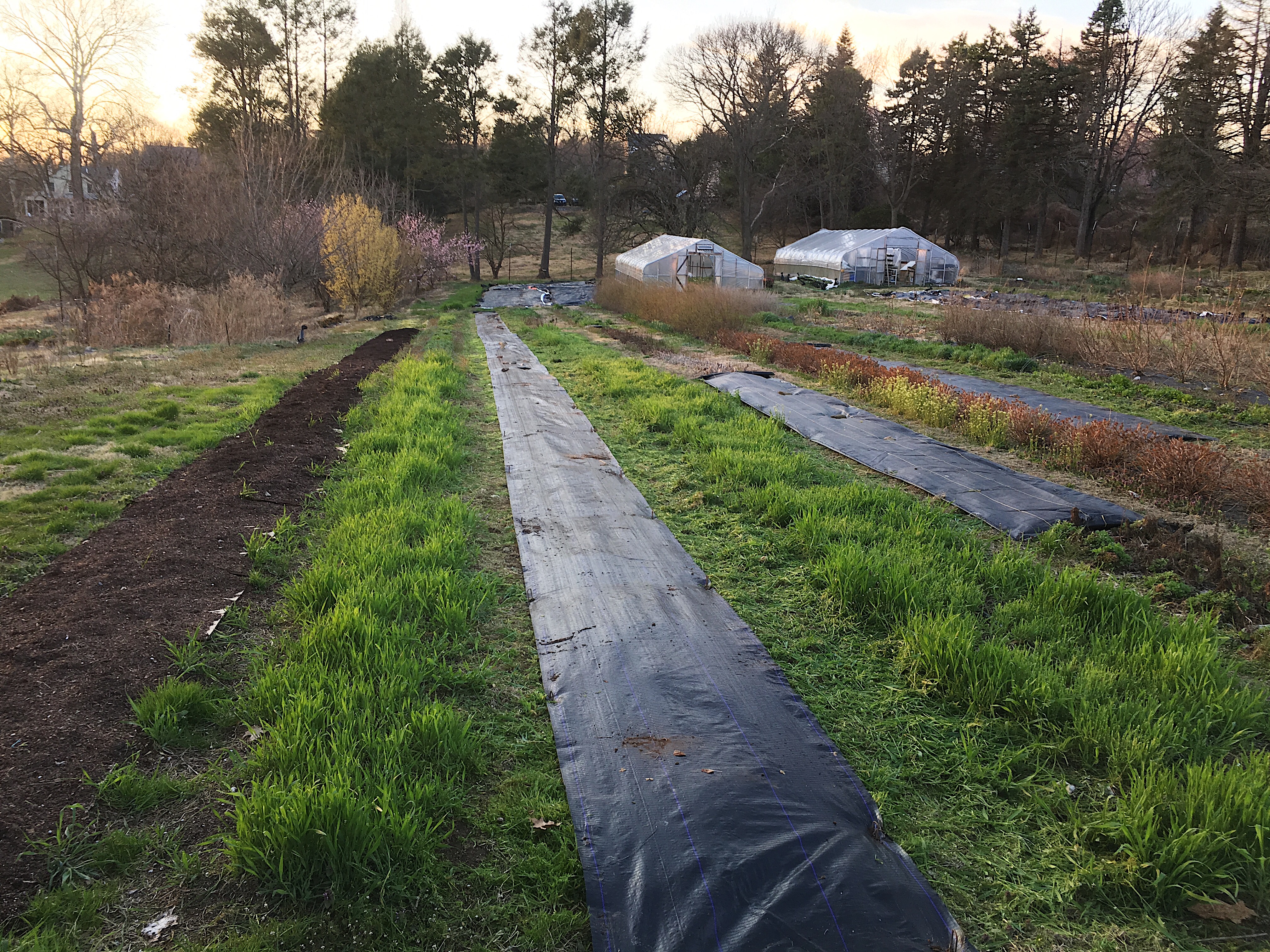
I was recently asked to chat “on the record” about my use of living walkways at the farm over on No-Till Growers podcast. In preparation for that, I jotted down some notes on a discarded brown-paper bouquet sleeve while I ate my (always hurried) lunch and then realized this would make a good blog post.
Before we can really dive into five reasons to have living walkways on a small farm, we have to address the alternatives to living walkways. Other options for maintaining the walkways on a small farm are to cultivate aisles regularly, to mulch pathways heavily, or to lay down large swaths of plastic/landscape fabric, all in the name of suppressing weeds and making life “easier” on the farmer. But I’d like to challenge those approaches and ask you to consider putting in living walkways at your small farm (or home garden).
5 Reasons to Have Living Walkways at Your Small Farm
1) Living Walkways on a Small Farm Feed the Soil
Unlike the alternatives (listed above), having living walkways means there are living roots in the ground which ultimately feed your farm or garden’s soil. Weeds pop up in walkways because Nature always (ALWAYS!!!) wants something growing on every centimetre of soil surface because ultimately the vast universe of life under the ground is highly dependent on the life above the soil. Roots from plants, be it “weeds” or your desired vegetation, give off sugar exudates and sloth off “skin” that feed all the microorganisms in the soil. In exchange, those hardworking little soil guys mine minerals and draw up water for the plants. It’s a beautiful barter system! Farmers who support this magnificent trade route going all the way from plant leaf tips down to fungi and vertebrates in the soil will see an increase in production and a healthier ecosystem at their farm.
The above is in contrast to the other ways of managing walkways that leave barren strips of “desert” between your planting beds, which makes it challenging for soil life to migrate and thrive. When you’re microscopic in size, crossing two feet of the Sahara wouldn’t be top on your list of things to do on the weekend, right?

2) Living Walkways on a Small Farm Reduce Runoff
Picture a torrential summer rainstorm. Now picture your walkways between planting beds while those buckets of water fall down out of the sky. If you have landscape fabric down, those walkways become gutters gushing with rainwater hurrying off your field. Do you really want rainwater leaving your field? I sure don’t! All that runoff also overburdens local waterways and may take too many nutrients with it, polluting the water.
If you have cultivated aisles instead, you’ll likely loose a lot of soil with the runoff and your plants will get splashed with a lot of mud, making your job harder when it comes to processing for market. Also, the impact of all those rain drops will create even more compaction in your soil.
Mulched aisles are pretty decent at mitigating some of the problems created by landscape fabric and cultivated aisles during heavy rain. But, the downside of mulch is that mulch itself can get washed away in a heavy downpour. D’oh!
Living walkways create a naturally absorbent surface that’s attached to the ground by the roots so it’s not going to wash away. Those roots also hold all the soil in place during the downpour so you don’t loose a single aggregate. And all that rich soil life I mentioned in Reason 1 is quick to soak up the rain water and provide an absorbent sponge that will slowly release water back to your crops’ roots as they need it over the coming days. Team work makes the dream work!
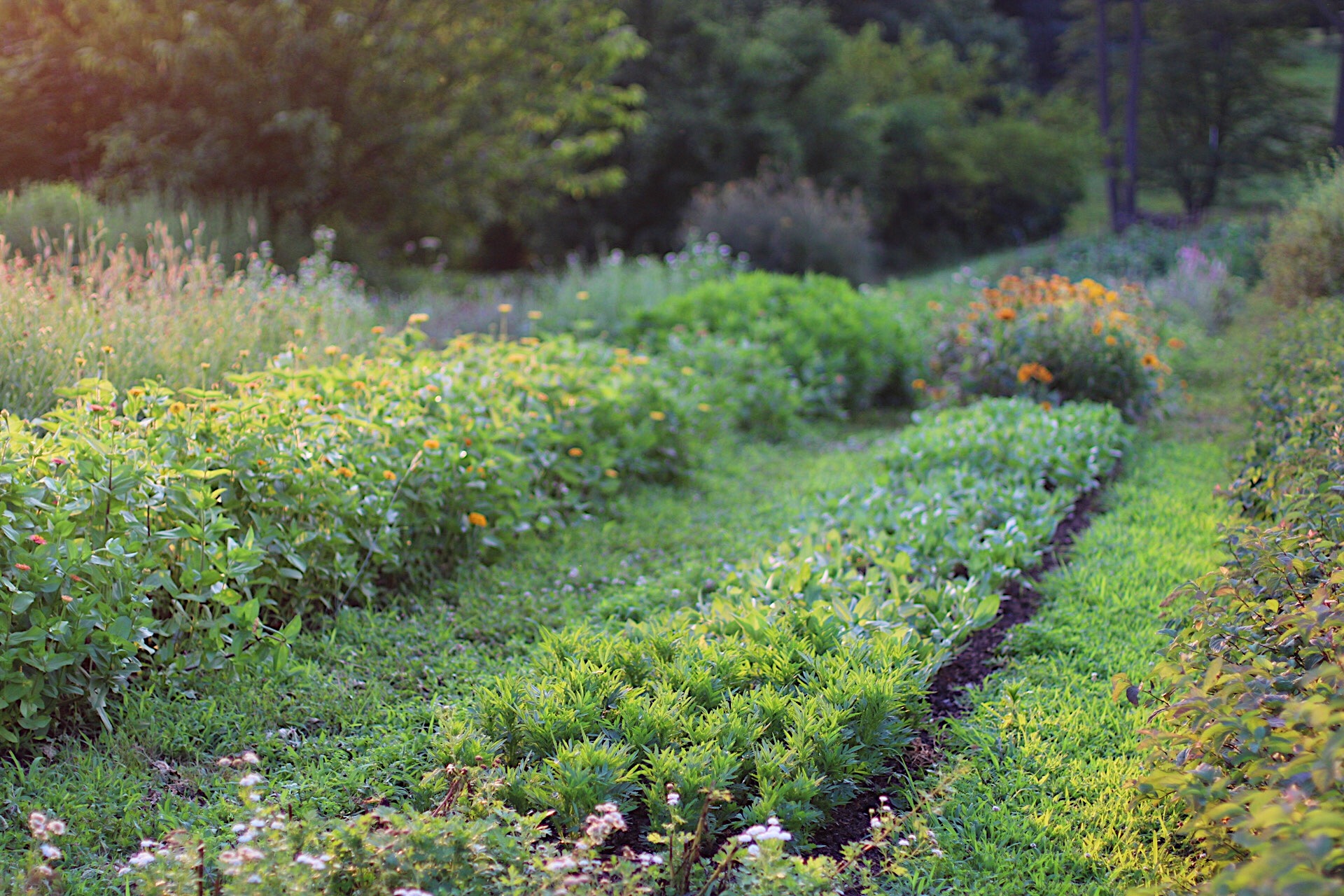
3) Living Walkways on a Small Farm Are Relatively Easy to Maintain
So, when I mention living walkways to other farmers, the major gripe I hear is about how hard it is to maintain them. Well, I’m here to tell you that’s a myth! I’d much rather pull out my push mower once a week and spend about 30 minutes zipping up and down the walkways than I would spreading a lot of heavy mulch, scuffling with a hoe, or pulling weeds out of landscape fabric (when they ultimately show up in the heat of July, which they always do).
The key to maintaining living walkways on a small farm with relative ease is to be consistent with your mowing routine. We mow once a week, religiously, at my farm. We’ve created aisles that are 21” in width, which is the exact width of the push mower. We use a mulching push mower with an adjustable height deck and strong (for a push mower) engine. Sharpening the blades a few times a season really helps too. With this system, mowing the aisles is a breeze.
But word to the wise: NEVER SKIP A WEEK OF MOWING!
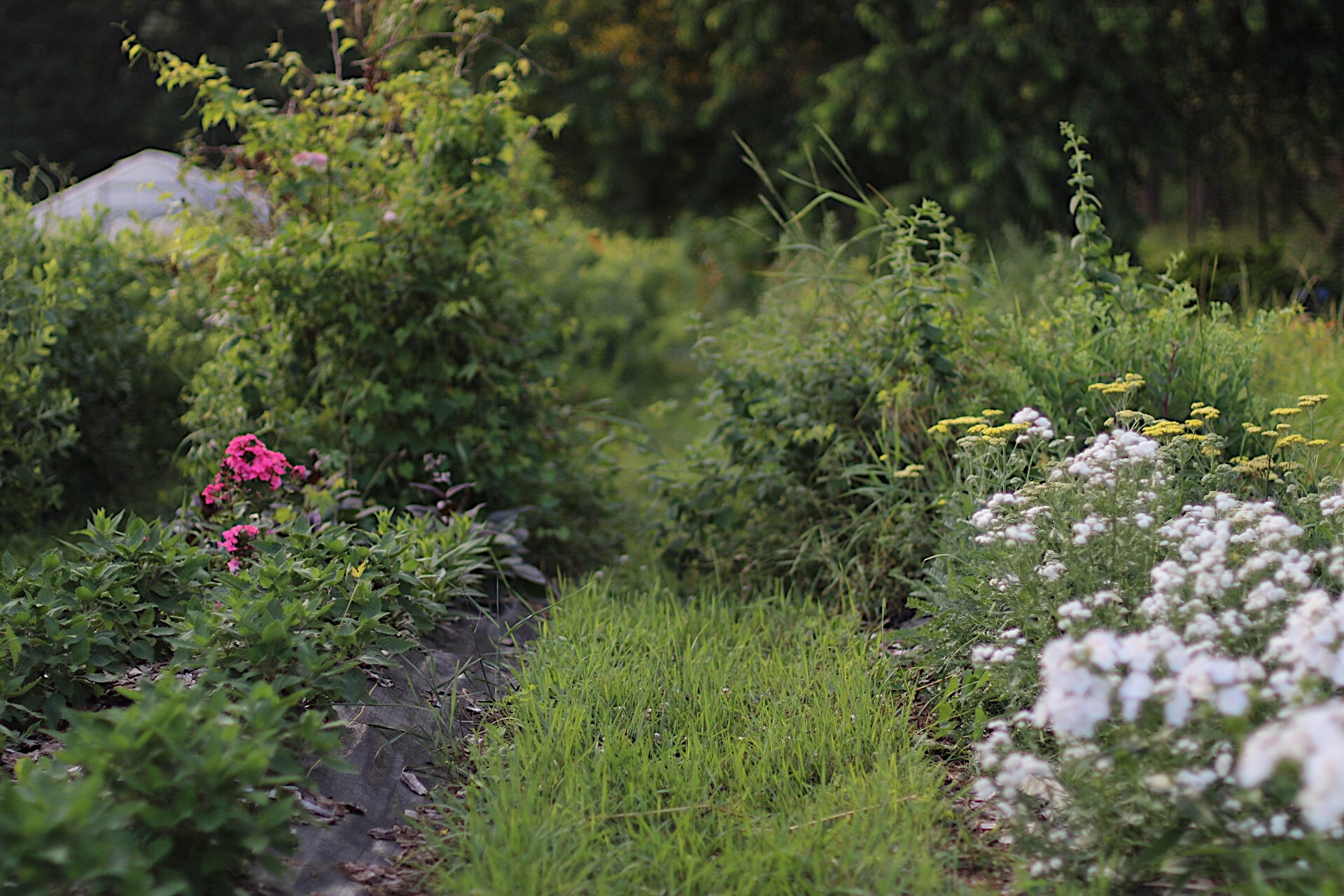
4) Living Walkways on a Small Farm Provide a Cooling Effect
In the world of small-scale flower farming, carpeting an entire field in landscape fabric somehow became a big trend. Perhaps this works well if your farm is in a cool temperate climate. But here in Hades-hot and rivaling-the-tropics-humid Philadelphia, all that black landscape fabric turns into a frying pan on a bright sunny day. Even cultivated or mulched walkways tend to create a heat sink, particularly if your soil is dark or you’re using a dark compost for mulch.
In contrast, the green of the living walkways creates a cooling effect that brings down the overall temperature of your field by a few degrees. You’ll appreciate that and your crops will appreciate it too!
5) Living Walkways on a Small Farm Beautify the Farm
Well, this one is pretty straight forward but one that is very much worth mentioning. I’ve tried other systems for walkways and none have made me feel quite so happy to be at my farm as living walkways have. It just feels natural, you know?
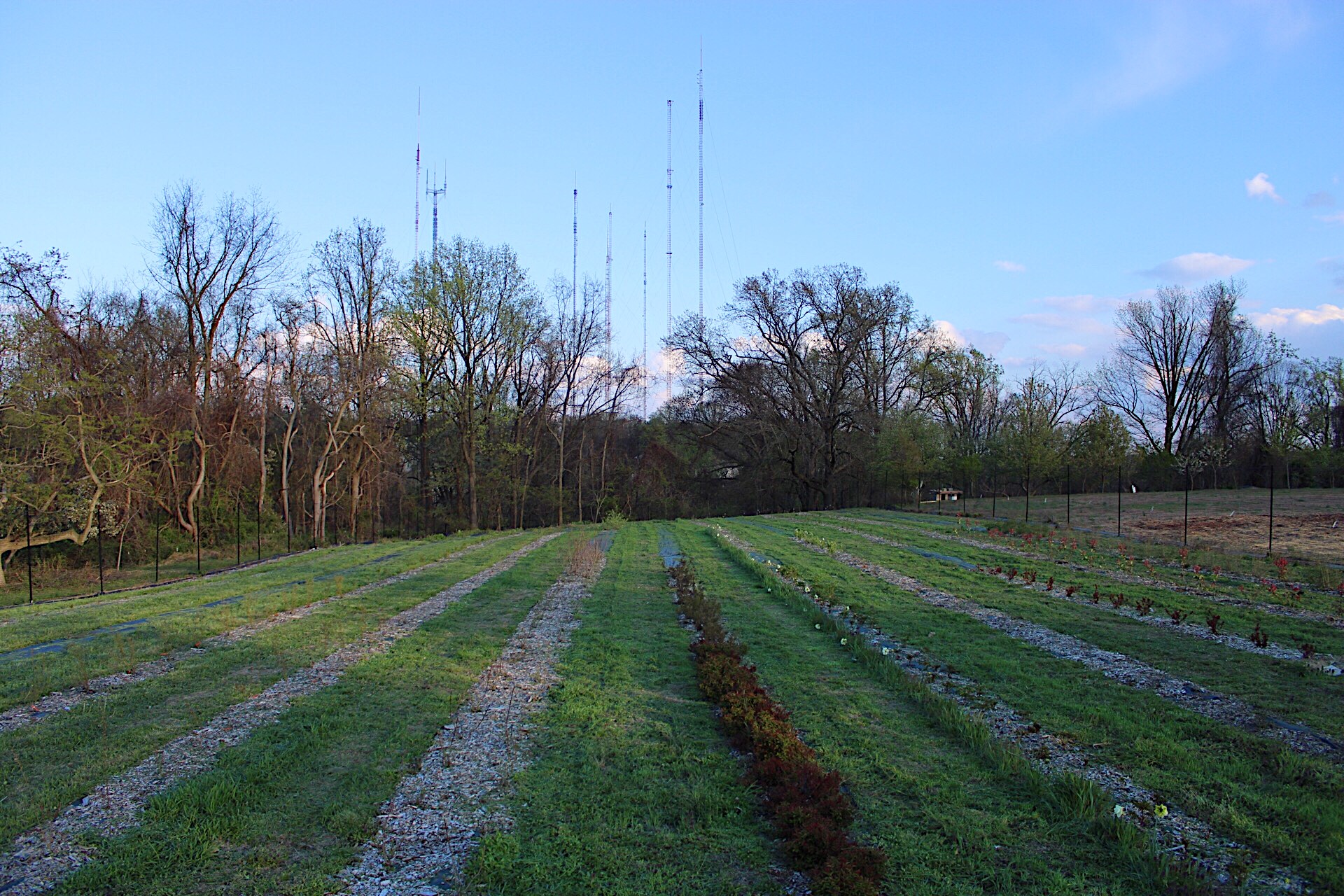
So now that I’ve hopefully gotten you thinking about creating living walkways on a small farm of your own, here are a few tips/thoughts to help you along the (walk)way.
• If you’re starting from scratch with bare soil, sow clover seed to start. In my experience, the clover won’t hold its own for very long, but it at least gets something growing on your soil surface to discourage any truly beastly weeds from showing up and hogging all the space. Eventually the “native” grass just took over our walkways here and that’s been great!
• As I mentioned above, but I’ll repeat: mow religiously once a week! Even when your walkways are just getting established and the vegetation is patchy, run that mower real quick and get in the habit.
• Make your walkways the width of the mower you plan to use. For us, that means 21” for the narrow walkways between our annual beds and 60” for the wide grassy aisles in our woodies/shrubs field. Make sure your mower(s) are a fairly standard size because eventually they’ll wear out and you want to be able to easily get a new one that matches your walkways perfectly.
• Use a MULCHING push mower for narrow walkways. Mulching mowers drop the clippings straight down on the ground rather than spitting it out the side and dirtying your crops. Mulching mowers are usually a little bit more expensive because they need a stronger motor but it’s absolutely worth investing in one.
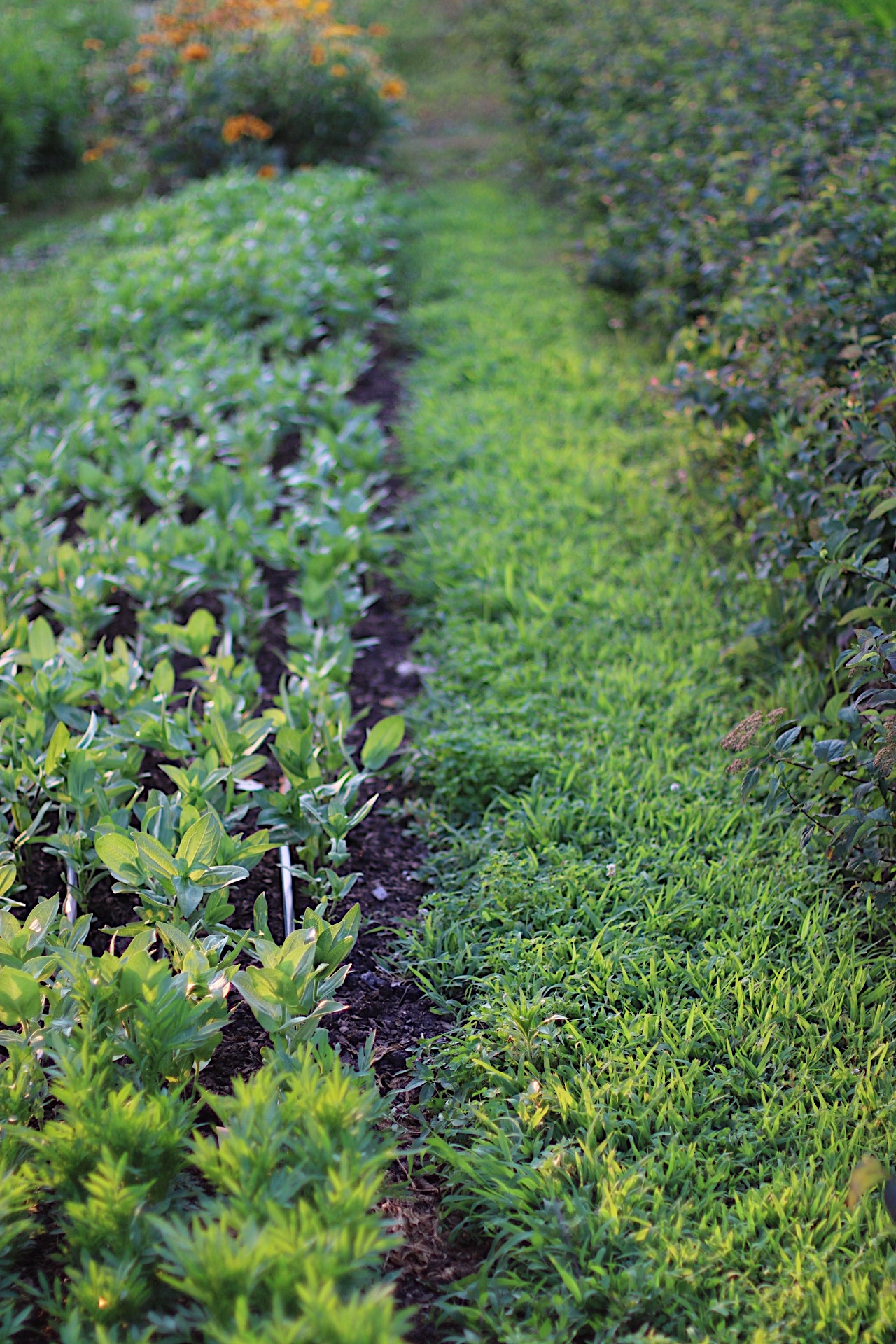
• Living walkways work in beautiful harmony with deep-mulch no-till planting beds. We’re able to run the mower right up to the edge of the bed without fear of catching landscape fabric in the blades. It’s easy to pull creeping grasses off the deep-mulch no-till beds and lay them out in the walkway for the mower to zip over to quickly terminate them. When you have landscape fabric on beds and living walkways, the creeping grass (i.e., crabgrass) can get really ensnared in the fabric and even when you get it off the fabric, you can’t run a mower along the edge because the fabric will catch. So, yep, big thumbs up for a deep-mulch no-till system in this regards (and many others)!
So, who’s going to consider living walkways on their small farm after reading this? Hands in the air!

Jennie,
I love the sound of this approach. This has been my first year farming and trying to decide how I want to proceed next season. I pretty much had a living walkway this year on one of my beds/walkways but it was too narrow to mow so was a bit of a nightmare. Are your living walkways mostly what would be considered weeds, but you just keep them mowed?
Welcome to flower farming, Amanda! Yep, our walkways are essentially “weeds”…just whatever nature decided to pop up in them (save for that very first sowing of clover that I did). The weekly mowing keeps them in check easily and the walkways look like tidy grass paths. Definitely make your walkways wider next season. Mine are 21” wide, which is the width of the push mower I use. Give that a shot and I bet you’ll find maintaining pathways is pretty easy AND you’ll be able to be more efficient when harvesting if you give yourself a little more room to move around in between rows.
Jennie, thank you so much for responding to me and everyone else! I thoroughly enjoy your blog and IG account! What a huge help you are to aspiring flower farmers!! It can be so overwhelming starting out and not knowing how to approach given circumstances. Really appreciate how helpful you are!!
Hands in the air over here! I’ve considered this before but figured “other places” have better behaved grasses than I do. I need to put more thought to this and research my options based on where I live. Thank you for suggesting the clover to get started. Sometimes it’s that first tip that helps to get the momentum rolling!
Trust me when I say our grasses are not “better behaved” in any way! Hahah! The real difference lately has been transitioning to no-till means that we are no longer chopping up the crabgrass into a million little viable bits when we till, which made it super mad/happy/aggressive. Now that we aren’t tilling, the crabgrass (and other creeping grasses) is much easier to manage. The way I see it, it’s either spend a lot of money and time on mulching or laying landscape fabric OR make beds faster/easier in the spring and keep them weeded some. In the end, I think the time/money input is about the same. But with the living walkways, the little guys in the soil are SO MUCH HAPPIER! 🙂
This is so good!! Thank you for writing this post, I always learn so much from you!
Aw, thanks, Scott! 🙂
How do you keep that grass from growing into the beds?
Head over to listen to this podcast where I talk about maintaining the beds:
https://www.notillgrowers.com/blog/2020/7/20/s3-living-pathways-w-jennie-love-of-love-n-fresh-flowers
Was awesome podcast. Hand is up and have a blank pasture that is a new start up. I have message you on Instagram. But will ask. Thinking about leaving the soil as is with established grasses and just doing a light forking. I am also starting a school based market farm/ flower you pick. Here in Texas. Any flower advice. Thanks in advance
Good questions, Mark! Glad your hand is up! I had this exact same scenario with a brand new field I opened up in the spring of 2018 from previously overgrown pasture/meadow (it’s the one pictured in this post with the tall tan rye grass down the middle of the pathways). Your approach would depend on what kind of plant life is already present. If you pasture has been grazed and/or mown, you can probably go straight into making beds and not disturb the soil at all. I had some really nasty invasive species on my ground when I first started (multiflora rose, bittersweet, devil’s walking stick, etc) so as much as it pained me, I did till a single time so that I could get at the roots of these invasives and pull them out of the ground. It was a long, back-breaking process over several months. I cover cropped that field consecutively for 12 months and then planted it in the spring of 2019. To get the beds established then, I laid black landscape fabric just where I wanted the rows to be (again, take a look at that picture in this post) and pinned that in place for about three weeks without planting anything so that it would smother the growth under it. Then we unpinned one side of the fabric on each row and uncovered the rows so we could go back in and spread compost on each row and add a few organic soil amendments (mostly cotton seed meal as the soil test said the field was low in nitrogen). We pinned the black fabric back over the beds and left it all sit for another two weeks just to let the soil biology adjust to the new format. Then we planted the crops into the black fabric because this field is being used for long-lived, large shrubs rather than annuals. The black fabric was then covered with wood chips that we inoculated with fungi to boost soil activity since I was really hating using the black fabric.
Sooooo… that’s a long answer that I’m not sure if it will be helpful, but hopefully you can draw a few nuggets from that. Sounds like you’ll be planting annuals in your new beds. In that case, I would still use the black landscape fabric to smother out the growth on the beds but then when it comes time to actually plant, I’d shift to the cardboard/deep mulch system we use for annuals here at my farm. I’ve got lots of blog posts that you might want to poke around in that case. 😉
Good luck!
Mark, I’m just south of San Antonio and like to send a friendly “hello” whenever someone mentions that they are from Texas. If you let me know what part of the state you’re in, we can become farmer friends!
Hi Jennie, thank you so much for this post! Hand in the air for considering living walkways. Do you have thoughts on how to establish new paths while the beds are in constant use? ie After seeding something like clover, how would you walk the beds while giving the crop time to germinate and get (somewhat) established? All I can think of is stepping stones. Thanks!
Good question, Alison! Are your paths currently cultivated or mulched? If they are mulched then I’d just wait until the end of the season and sow winter rye into the walkways and let that have the winter to get established when you’re not walking around the beds so much. If the paths are cultivated, then I’d personally probably mulch them now to get the soil some cover and then go with the winter rye come fall. I don’t think there’s much you can sow in the summer that will withstand lots of walking over as it germinates. And the stepping stones won’t really solve the problem since you want to be able to mow the aisles regularly.
Thank you so much!
Thank you so much for this post. I have been going back and forth all season on what is the best approach. My instinct was living walkways, but when I see pictures of other farms, their paths are either deserts or landscape fabric. Thank you for pointing the way. Sold!
I heard your podcast this morning and am so glad you followed up with this article. We have tried everything. We are just now taking up landscape fabric we put in the aisles last year. They are harborers of weeds that spread by runners. The weeds are worst at the edges of it. And other weeds grow right through it. We didn’t want to cover our beds with landscape fabric. We are also working with no till and trying to establish healthy soil life. Not to mention it is HOT in Texas. We will have to widen our paths probably, but my husband has been wanting to do that for a while. Thanks again for some hope.
Although I love mulching mowers; we use the old fashioned reel mowers that drop clippings directly down into the grass and run off human power only. There is something so satisfying about mowing this way although the deck would only be wide enough for you to mow the rows taking two swipes instead of one as reel mowers are much more narrow than traditional.
That sounds great, except I’m pretty sure my crew would quit on me if I asked them to use a reel mower! 😉
Hi Jennie! I have living walkways right now in my garden and I absolutely love it! Next year I would like to install drip irrigation, but am worried about mowing (Actually we weed wack the pathways) and having all that tubing around. I was assuming I would have to go with mulch or landscape fabric. Unless you have another idea?!?!
We have drip irrigation. It’s not a problem at all with the living pathways. Where the pathways are, we tuck the header line under about an inch of soil (just use a shovel to “pop” the turf up and tuck the tube under) and that way we don’t hit it with the mower.
This is such a great post and we loved the podcast as well. Thank you for sharing the knowledge! Kind of tangential question, but I haven’t noticed much plastic netting on your flowers in your recent no-till posts. Looks like you may be using more of a corral method. Are you moving away from plastic netting? I’m trying to use less of it but get nervous!
Thanks for this article! My flower field is in the low ground on my farm and I find my living walk ways really help absorb some of the water. I do use landscape fabric but I find if I set me mower on the highest setting I can still zip over it without it catching (as long as the fabric is stretched tight the way it should be). Thanks again for this article!
I’ve used mini clover to provide a green path between my beds. I’ve used my weed wacker maybe 6 times this summer to “train” it to stay low. It is a good alternative to grass. Less aggressive in the wandering like grass can be.
Great recommendation! I can’t seem to get clover to establish very well at my farm, but it’s definitely more preferable to grass!
Hi! I’m so glad I found this article, it has been so helpful in planning for next year! I am curious though, how would you establish walking paths for a new garden that is currently bare soil/compost? I am turning a hillside in my yard to terraced beds. Each terrace will be 6′ wide, 4′ for the flower bed and 2′ for a walking path. Since the terraces are new and have nothing growing in them, do I cover crop the entire thing with winter rye, vetch, cow peas and clover, mow in the spring and then put down clover again just in my walking paths? Or do I establish my walking paths now and only put clover in the paths and do the combo of cover crops where I’ll actually be planting the flowers?
Either of those approaches should work, Erin. If I were you, I’d cover crop the entire space with winter rye to stabilize the soil and get something green growing. Bare soil is never good.
Hi Jennie, one problem, I don’t own a mower as my farm takes up all my available growing real estate .. about a 1/8 to 1/4 acre. Ive been using wood chips so far in walkways but could consider the old fashion push blade mower.
I hope i didn’t miss this somewhere but wondered what brand mower you use? i am looking at yardmax or craftsman which look available at my nearby stores. Your podcast interview and these blog posts are so helpful for me as I try to transition my tiny farm into a no plastic space. i have been trying every way to bring organic matter up including mulching everything with a real rickity regular push mower that throws debris to the side! thanks for any guidance!
So glad the post is helpful! I currently have a Poulan, but have used a Craftsman in the past.
Hello, In February, I covered my hard grassy/weedy space with deep layers of cardboard ( 6 layers ), and have pulled out the few weeds that have come through the cardboard. I want to grow flowers, but not sure how deep the compost should be. After reading your blog, I’d like to create natural paths instead of brick. Any suggestions are so welcomed and appreciated. I’m growing on 1/8th acre in my backyard. Thank you!!!
I am expanding onto a brand new acre this year (I’ve grown in raised beds for 5 years) and was on the fence – this definitely tipped me towards living walkways! And I am going to try deep mulch with rolls of paper instead of plastic for the rows. I have a 42″ wide JD riding mower that I can put a bag on and if I make my rows same width, do you think that would work? Or do you strongly recommend push mower for the sake of better control amongst the plants? Thank you so much! I always love your blogs, and appreciate you sharing your wonderful wealth of knowledge.
A riding mower would work just fine too. Just important to not throw grass cuttings onto the flower rows. But with a bagger, it should be just fine. 🙂 Good luck with the new acre! So exciting!
Hi. As I look at the big pile of mulch that I want to move into my paths this way, I’m seriously considering switching to living pathways for next season. I do have a big bag of grass seed a friend gave me, but I’m also looking in the field and see some chamomile that seems to have done a great job of overwintering this past winter, and considering using that instead of grass. I’m in zone 6b/7a. Thoughts?
Hi Jennie,
Thank you for this! I’m a big fan of No-Till Growers and am always trying to incorporate new techniques into my home garden. Do you have recommendations for other types of living pathways besides grass? I apologize if this inquiry had already been posed!
Thank you for this! I have grass walkways between my rows which I mow to I had been considering fabric for pathways or even just mulch and hoeing weeds but after reading this it makes so much sence to keep what i have but I am going to make my walk ways narrower to the size of my mower to fit more growing space in not sure why I hadnt thought of that!